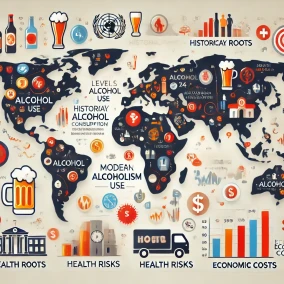Alcoholism Statistics: Alcohol Use around the Globe
Alcohol, Addiction Data
Alcohol is one of the most widely consumed substances in the world. The history of alcohol consumption dates back thousands of years, and evidence of alcohol consumption is found in records of civilizations as old as the Ancient Egyptians and the Mesopotamians.
Although many cultures and religions (such as Islam, Sikhism etc.) discourage or even prohibit consumption of alcohol, alcohol is consumed on some scale in almost every part of the world today. In countries which have a drinking culture, alcohol consumption is very high, and many recreational activities revolve around alcohol consumption.
This leads, in many cases, to alcoholism, which results in serious harm to the physical as well as economic and social health of individuals in these countries. The economic costs alone are often substantial.
Alcoholism statistics from Australia show that, of total drug abuse costs, alcohol abuse accounts for an estimated 24%. It was estimated that the in the US the economic costs of all forms of alcoholism exceeded $223.5 billion in 2006. A similar study in 2001 put the number at over £18 billion for the UK. The World Health Organization estimates that economic costs of alcohol misuse vary from 1% to 6% depending on the country.
According to the World Health Organization (WHO), Europe is the world leader when it comes to alcohol consumption. Alcoholism statistics provided by the WHO reveal that one-fifth of the population of Europe aged 15 and above reports heavy drinking (more than 60g of alcohol) at least once a week. It also has the highest proportion in the world of ill health and death due to alcohol.
Alcohol abuse is also on the rise in Asia. According to one study, 2.3% of all deaths in Southeast Asia in the year 2004 were due to alcohol. The figure was over 5% in the Western Pacific region. The alcoholism statistics indicate that among Asian countries, consumption is highest among the more developed economies.
In Australia, New Zealand, Japan and South Korea, individuals aged 15 and over drank over 7 liters of alcohol per capita in 2008. However, the overall average consumption among the Asia/Pacific countries in 2008 was only 2.4 liters per capita. This shows that there is a stark difference between the amounts of alcohol consumed by more developed countries and countries that are less so.
While the statistics for alcohol consumption in Asia/Pacific are not very encouraging, alcoholism statistics for Asian countries are even bleaker. According to the WHO, in 2005 22% of drinkers in Southeast Asia reported incidences of heavy drinking during the past 12 months. In Australia, one in five people aged 14 and over were at risk of alcohol related ill health during their lifetime.
In Japan and the Laos Republic the same year, around 20% of males reported heavy drinking on a regular basis. In China, alcohol consumption is rising quicker than anywhere else in the world. This is thought to be partly due to China’s economic growth and the consequent rise in disposable income levels. The per capita consumption of alcohol in China (for people aged 15 and above) has risen from 2.5 liters in 1978 to 4.9 liters in 2009. This clearly shows how steeply alcohol consumption has increased in the three decades in China.
Alcoholism statistics for Africa paint an interesting picture. Although per capita consumption levels in the continent are not particularly high, Africa leads the world when it comes to the proportion of binge drinkers compared to total drinkers. For instance, while 85% of the population of Kenya reported not having drunk any alcohol in the past year, those who had done so had consumed almost twice as much as an average drinker in the UK. Therefore, while Africa does not seem to have a drinking problem overall, it does seem to have a binge drinking problem.
Overall, many parts of the world have a serious alcoholism problem, leading to massive medical, social and economic costs. The sooner we bring this problem under control, the better it will be for the human race.
